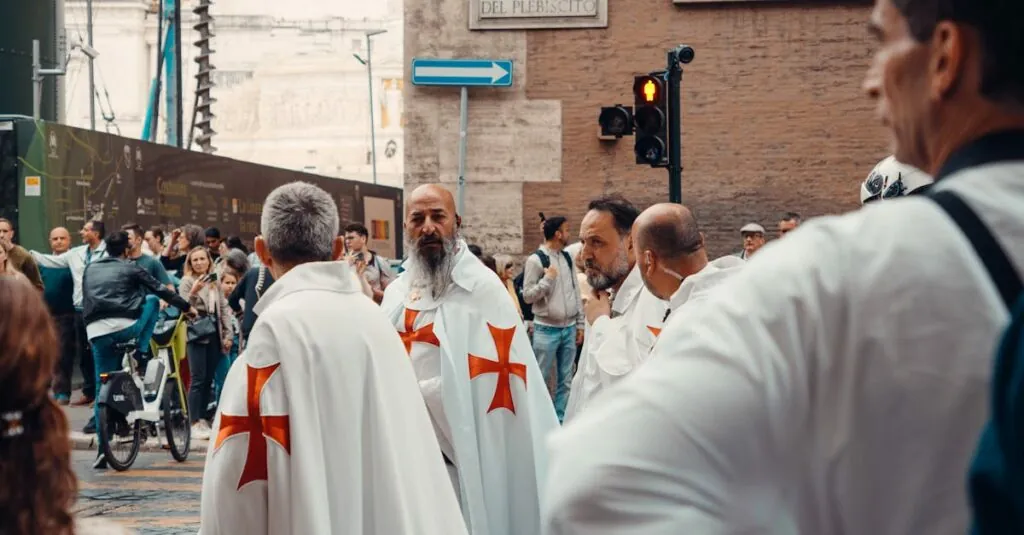Table of Contents
ToggleItaly isn’t just a country; it’s a vibrant tapestry of art, history, and culinary delights that could make anyone swoon. From the passionate gestures of Italians to the mouthwatering aroma of fresh pasta wafting through the streets, Italian culture captivates the senses and invites exploration. Who wouldn’t want to dive into a world where coffee is an art form and every meal feels like a family reunion?
Overview of Italian Culture
Italian culture stands out due to its profound historical roots and artistic contributions. Relics from Roman times and Renaissance masterpieces exhibit the nation’s dedication to art and history. The country boasts UNESCO World Heritage Sites, with more than 58 recognized locations. Each site represents Italy’s artistic excellence and historical significance.
Cuisine plays a crucial role in daily life. Ingredients are fresh, often local, and meals prioritize quality. Traditional dishes include pasta, pizzas, and risottos, each varying by region. Dining experiences are communal; family and friends gather around tables for lengthy meals filled with laughter.
Art forms an intrinsic part of Italian identity. Renowned artists such as Leonardo da Vinci and Michelangelo shaped Western art. Masterpieces can be found in galleries and cathedrals across the nation. Festivals celebrating art, like the Venice Biennale, attract global attention.
Language enriches cultural expression. Italian, a melodic language, reflects the country’s artistic heritage. Regional dialects add local flavor, preserving unique customs and traditions. Various expressions in Italian literature also capture national identity.
Music resonates deeply within Italian society. Opera, a creation of Italian heritage, displays emotional depth and intricate compositions. Instruments like the mandolin and accordion are popular in traditional folk music, highlighting local culture.
Sports hold a prominent place in everyday life. Soccer leads as the most popular sport, fostering camaraderie and regional pride. Events like the Palio di Siena blend athletics and tradition, showcasing Italy’s competitive spirit.
Each aspect of Italian culture provides a dynamic experience, inviting exploration and appreciation of its rich tapestry. Celebrating life, harmony, and community defines Italy’s cultural essence.
Historical Influences on Italian Culture
Italian culture reflects a tapestry of historical influences that shaped its identity. Key eras like Ancient Rome and the Renaissance have left lasting legacies.
Ancient Rome and Its Legacy
Ancient Rome laid the foundation for contemporary Italian culture. The empire’s advancements in architecture, law, and governance continue to influence modern Italy. With structures like the Colosseum and aqueducts, the Romans demonstrated innovation in engineering. Their legal principles set the groundwork for Italy’s judicial system. Language also thrived during this period, as Latin evolved into the Italian language spoken today. Furthermore, the social dynamics of Ancient Rome fostered a strong sense of communal identity that persists in Italian society.
The Renaissance: A Cultural Rebirth
The Renaissance marked a pivotal turning point in Italian culture. This period spanned the 14th to the 17th century and emphasized humanism, art, and intellectual exploration. Artists like Leonardo da Vinci and Michelangelo transformed the visual arts, pushing boundaries with masterpieces still revered today. In addition, innovations in philosophy and science emerged, particularly with figures like Galileo and Machiavelli shaping modern thought. Literature flourished as well, with writers such as Dante and Petrarch influencing the Italian language and literary tradition. This rich cultural rebirth highlighted creativity, expressions of beauty, and a renewed connection to classical antiquity.
Key Aspects of Italian Culture
Italian culture is a mosaic of languages, flavors, artistry, and traditions. Each aspect adds to the rich tapestry that defines this captivating nation.
Language and Dialects
Italian serves as the country’s official language, yet more than 30 different dialects exist. Regional dialects vary significantly, with local expressions preserving historical customs. These dialects reflect Italy’s diverse heritage, enriching the cultural landscape. Communication balances between standard Italian and regional phrases, showcasing identity and belonging. Additionally, dialects often include unique vocabulary and grammar, allowing individuals to express their cultural roots. Language connects communities, reinforcing bonds among Italians. This linguistic diversity emphasizes how culture thrives throughout Italy.
Italian Cuisine and Culinary Traditions
Italian cuisine highlights the importance of fresh, local ingredients. Each region boasts distinct dishes such as Neapolitan pizza and Sicilian arancini, showcasing culinary diversity. Meals transcend mere sustenance, often involving elaborate gatherings with family and friends. Communal dining creates a warm atmosphere filled with conversation and laughter. Culinary traditions emphasize simplicity, focusing on bold flavors rather than complexity. Seasonal ingredients drive menus, ensuring freshness and taste. Italian food reflects regional pride and cultural history, making every dish a story on a plate.
Art and Architecture
Artistic expression forms the foundation of Italian identity. Renowned artists like Leonardo da Vinci and Michelangelo left an indelible mark on Western civilization. Cities like Florence and Rome serve as open-air galleries, showcasing sculptures, paintings, and architecture. Renowned landmarks, such as the Colosseum and St. Peter’s Basilica, demonstrate Italy’s rich architectural heritage. Moreover, contemporary art movements continue to thrive, blending tradition with modern innovation. Art festivals, like the Venice Biennale, draw global attention, inviting admiration and inspiration from visitors. This dynamic artistic scene reflects Italy’s ongoing cultural evolution.
Festivals and Traditions
Italy’s festivals and traditions showcase the country’s rich cultural tapestry. They celebrate community, history, and local customs, reflecting unique regional characteristics.
Major Italian Festivals
Carnival stands out as one of Italy’s most famous festivals, particularly in Venice, where elaborate masks and costumes create a mesmerizing spectacle. Each February, locals and visitors participate in parades featuring floats, music, and theatrical performances. Another highlight, the Palio di Siena, occurs twice a year in July and August, showcasing intense horse races in Siena’s historic city center. Italians also honor religious celebrations, such as Easter, marked by vibrant processions and special feasts throughout the country. These events draw crowds, fostering a sense of shared heritage and excitement in various Italian cities.
Regional Traditions and Customs
Regional traditions enrich Italy’s cultural diversity. In the South, Tarantella dances celebrate joyful gatherings, often accompanied by lively music. Fresh, seasonal ingredients take center stage in cuisines, with each region boasting distinct dishes that reflect local flavors. Northern areas, like Piedmont, uphold traditions of truffle hunting, organizing festivals to celebrate this culinary treasure. Tuscany’s grape harvests feature wine festivals, drawing enthusiasts eager for tastings and celebrations. Such customs foster community bonds, highlighting Italy’s regional pride and dedication to preserving its rich historical influences.
Italy’s cultural landscape is a vibrant blend of history art and culinary delights. Each region tells its own story through unique traditions and flavors inviting exploration and appreciation. The passion of the Italian people shines through in their communal dining experiences and lively festivals which foster a strong sense of community.
From the masterpieces of the Renaissance to the lively rhythms of traditional music Italy continues to inspire and enchant. Its rich heritage is not just a reflection of the past but a living culture that evolves while staying deeply rooted in its historical influences. Embracing Italian culture offers a journey filled with beauty connection and a celebration of life itself.




